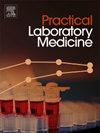Validation of an assay for NGAL in a pediatric population
IF 1.3
Q3 MEDICAL LABORATORY TECHNOLOGY
引用次数: 0
Abstract
Background and objectives
Acute kidney injury (AKI) poses a serious clinical challenge, particularly in high-risk environments, due to its association with increased morbidity and mortality. Traditional diagnostic markers, such as serum creatinine, often detect AKI only after significant kidney damage has occurred, limiting opportunities for early intervention. Neutrophil gelatinase-associated lipocalin (NGAL) has emerged as a promising early biomarker due to its rapid upregulation following kidney ischemia. NGAL supports renal recovery by reducing toxicity and promoting tubular regeneration via heme oxygenase-1 activity. This study aimed to validate the BioPorto ProNephro AKI™ turbidimetric immunoassay for urinary NGAL on the Ortho Vitros XT7600 analyzer and evaluate its clinical utility in detecting early-stage AKI.
Design and methods
Assay performance was evaluated in accordance with CLSI guidelines, assessing precision, linearity, method agreement, specificity, and reference range. Method comparison involved 20 urine samples, while reference range verification used 57 pediatric samples. A clinical validation study included 21 pediatric CRRT patient samples to assess real-world diagnostic performance.
Results
The assay demonstrated strong precision (intra-assay CV: 1.3–1.8 %; inter-assay CV: 1.8–2.7 %) and excellent linearity (18–1140 ng/mL; extended to 15,000 ng/mL with dilution). High correlation (r = 0.9836) was observed in method comparison. Specificity tests showed minimal interference. Clinical validation yielded 76.19 % sensitivity and 100 % specificity for AKI detection.
Conclusions
The BioPorto ProNephro AKI™ assay on the Ortho Vitros XT7600 shows high sensitivity and specificity for urinary NGAL detection in pediatric patients, enabling early AKI identification, timely intervention, and potentially improved clinical outcomes through enhanced diagnostic performance.
小儿NGAL检测方法的验证
背景和目的急性肾损伤(AKI)是一个严重的临床挑战,特别是在高风险环境中,由于其与发病率和死亡率增加有关。传统的诊断指标,如血清肌酐,通常只有在发生重大肾损害后才能检测到AKI,这限制了早期干预的机会。中性粒细胞明胶酶相关脂钙蛋白(NGAL)因其在肾缺血后的快速上调而成为一种有前景的早期生物标志物。NGAL通过降低毒性和通过血红素氧化酶-1活性促进肾小管再生来支持肾脏恢复。本研究旨在验证BioPorto proonephro AKI™浊度免疫法在Ortho Vitros XT7600分析仪上检测尿液NGAL,并评估其在检测早期AKI中的临床应用。设计和方法按照CLSI指南评估分析性能,评估精密度、线性度、方法一致性、特异性和参考范围。方法比较涉及20份尿液样本,而参考范围验证使用57份儿科样本。一项临床验证研究包括21例儿科CRRT患者样本,以评估真实世界的诊断性能。结果该方法具有较高的精密度(检测内CV: 1.3 ~ 1.8%;检测间CV: 1.8 - 2.7%),线性良好(18-1140 ng/mL;稀释后延长至15,000 ng/mL)。方法比较具有较高的相关性(r = 0.9836)。特异性试验显示干扰最小。临床验证AKI检测的敏感性为76.19%,特异性为100%。结论基于Ortho Vitros XT7600的BioPorto proonephro AKI™检测在儿科患者尿NGAL检测中具有较高的敏感性和特异性,可以早期识别AKI,及时干预,并通过提高诊断性能改善临床结果。
本文章由计算机程序翻译,如有差异,请以英文原文为准。
求助全文
约1分钟内获得全文
求助全文
来源期刊

Practical Laboratory Medicine
Health Professions-Radiological and Ultrasound Technology
CiteScore
3.50
自引率
0.00%
发文量
40
审稿时长
7 weeks
期刊介绍:
Practical Laboratory Medicine is a high-quality, peer-reviewed, international open-access journal publishing original research, new methods and critical evaluations, case reports and short papers in the fields of clinical chemistry and laboratory medicine. The objective of the journal is to provide practical information of immediate relevance to workers in clinical laboratories. The primary scope of the journal covers clinical chemistry, hematology, molecular biology and genetics relevant to laboratory medicine, microbiology, immunology, therapeutic drug monitoring and toxicology, laboratory management and informatics. We welcome papers which describe critical evaluations of biomarkers and their role in the diagnosis and treatment of clinically significant disease, validation of commercial and in-house IVD methods, method comparisons, interference reports, the development of new reagents and reference materials, reference range studies and regulatory compliance reports. Manuscripts describing the development of new methods applicable to laboratory medicine (including point-of-care testing) are particularly encouraged, even if preliminary or small scale.
 求助内容:
求助内容: 应助结果提醒方式:
应助结果提醒方式:


